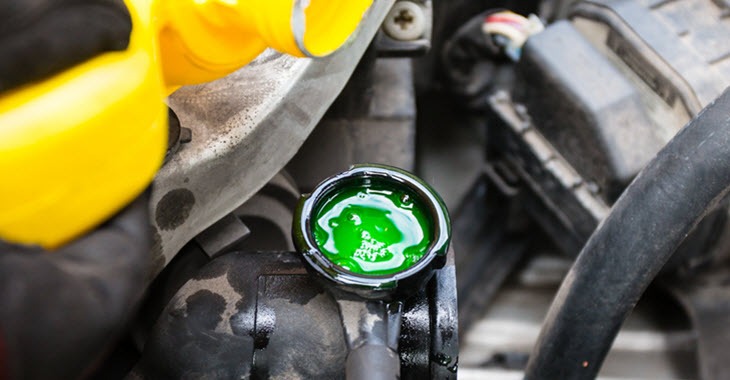Wow, what fantastic weather! And you plan to go on a drive. While reaching the car, you noticed green fluid leaking from the car. Imagine how annoying and heartbreaking it could be. So, to avoid such situations in life, you know how to deal with them. Here, our article will guide you with a few basic ways and techniques to solve the problem. So, let’s begin.
Table of Contents
What Is Green Liquid In A Car?
Green fluid is typically a coolant or antifreeze. Nowadays, these coolants are manufactured in various other colours too. It will smell sweet if it’s a coolant, but please don’t try to taste it.
It is a fluid responsible for cooling and protecting the heating system from rust. It also provides lubrication to the water pump. Leaking antifreeze from the car may result from multiple causes, like a failed radiator which is quite expensive to repair. It can also occur due to loosing of the hose clamp.
Reasons Why Green Fluid Leaking From Car?
There are a variety of reasons responsible for the leaking of green fluid from the car. These include holes in the radiator, leaky radiator cap, blown gasket and so on. A few of the reasons are briefly listed below:
1. There Is A Hole In The Radiator
 The engine parts have to endure many wears and extreme temperatures—all of these overheating parts are maintained by the radiator. Corrosion inside the radiator is one of the main reasons behind the leaked fluid.
The engine parts have to endure many wears and extreme temperatures—all of these overheating parts are maintained by the radiator. Corrosion inside the radiator is one of the main reasons behind the leaked fluid.
With the advancement of time, the radiator tube results in the accumulation of debris and dirt, causing the leak. Even the gasket near the radiator may wear out and cause a leak. Also, the hoses connected with the radiator get older and could leak.
2. Leaky Radiator Cap
Radiator cap, too, plays an important role. Although it’s a small part, it is responsible for maintaining correct pressure within the cooling system by creating a tight seal.
With time, either the seal is worn out and broken, or the spring may damage, causing fluid leakage.
3. Your Head Gasket Is Blown
It generally determines the engine’s functioning, i.e., one can know how well the machine works through it. We usually drive the car with a blown gasket as it is pretty challenging to analyse.
The Head gasket determines the wide range of temperature along with the pressure change in the engine. It lies between the cylinder head and the engine block.
When a leak is observed, the head gasket cannot fulfil its function of maintaining the engine resulting in its failure.
4. Water Pump Has Failed
The water pump system meant for controlling the circulating of coolant within the cooling system. It is located in the lowermost part of the engine. It connects the hose to the radiator and may even cause corrosion of the hose, resulting in leakage.
Whatsoever is the cause of the cooling system fails, it will result in engine overheating. And the overheating engine is not at all good for the vehicle.
5. Problem In Expansion Tank
 An expansion tank is a part of the cooling system used to maintain the engine’s temperature. The air in the expansion tank provides cushioning effect that allows the heated coolant to expand without failing the cooling system.
An expansion tank is a part of the cooling system used to maintain the engine’s temperature. The air in the expansion tank provides cushioning effect that allows the heated coolant to expand without failing the cooling system.
It is a plastic container lying beside the engine. With the advancement of time and exposure to temperatures, the parts of the expansion tank weaken.
The weakened tank might crack and causes leakage of fluid which lets coolant escape. As a result of this, the fluid leaks from the cooling system.
How To Fix Coolant Leak?
There are multiple ways to fix a coolant leak. A few of the standard methods are listed below:
1. The Egg Fix
When you are stuck with a coolant leak in the middle of the journey, you have an egg tray nearby. Then, fortunately, you are lucky and find the problem to your solution by following these simple steps:
- Let it cool for ten minutes.
- Pop the hood and the radiator cap.
- Crack and drop the two eggs in the radiator cap reservoir.
- Check to see whether the leak stopped or not. If it did, then great and if not, then drop a few more eggs on the radiator.
This old trick signifies that the heat cook the egg, and the pressure of the leak forced out the boiled egg. Thus, prevent leakage of coolant.
2. Replacing Old and Damaged hose clamp.
Here’s the way to deal with the problem. It includes the following steps:
- Let the car rest for five to ten minutes.
- Pop the hood and unlock the radiator cap.
- Locate the damaged hose clamp.
- Depending on the position of the damaged hose clamp, you may need to drain some coolant.
- Unscrew the damaged or worn-out hose clamp.
- Slide the new hose clamp onto the freed hose.
- Tighten the hose clampdown.
- Fill the radiator with new fluid.
- Turn on the car and check the new clamp for leaks.
3. Replacing A Radiator Hose
Different automotive manufacturers have a different locations for radiators, so one must read the manual to determine the correct way to replace the hose.
- Let the car cool for five to ten minutes.
- Pop the hood and locate your radiator.
- Disconnect the battery.
- Drains the left coolant from the radiator
- Once drained, removed the rest of the hoses.
- Remove the old thermostat.
- Plug the holes by taping over the outlets.

- Disconnect the fans and remove the nuts and the bolts.
- Install the fan bracketry on the new radiator.
- Insert new radiator and install new fans.
- Remove the tape from the hose and replace it with a new one.
- Reconnect all the new hoes with the radiator and fill the new radiator with fluid.
- Reconnect the battery.
- Switch on the car with the radiator cap off and check to see if there is any leak.
- If everything looks OK, then congrats, you did it.
Cost To Prevent Fluid Leakage?
If the above-listed measures fail to work, then the last option is to fix the leak in the garage. The average cost is around $730. If you catch the problem early that it may cost low to about $100. Fix your leakage quickly; otherwise, it would damage the engine.
Frequently Asked Questions:

So,here are some of the frequently asked question about what is green colour oil in car, why is my car leaking green etc?-
What Is Green Colour Oil In Car?
Are All Coolant Leaks Green?
Why Is My Car Leaking Green?
How Do I Know When My Radiator Is Bad?
- When Your vehicle is overheating. If your vehicle constantly overheats, this is one of the most common signs that your radiator is bad.
- Your vehicle is leaking coolant.
- Low coolant levels.
Is Transmission Fluid Green?
How Much Does It Cost To Fix Leaking Coolant?
Conclusion
We hope you got the answer now that why green fluid leaking from the car. If your doubts persist, then freely comment below, and we are always here to answer them all.



